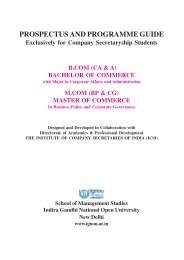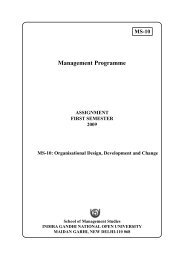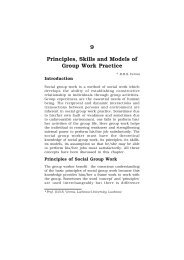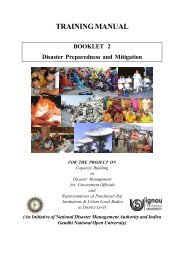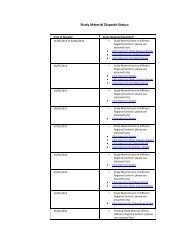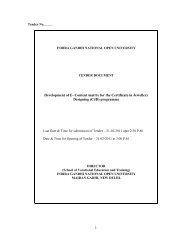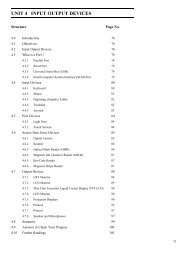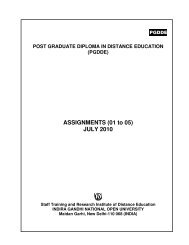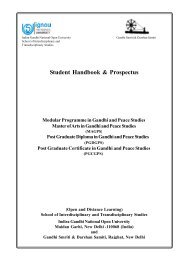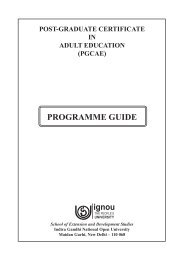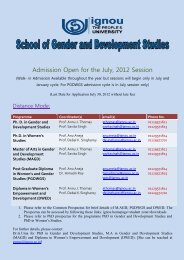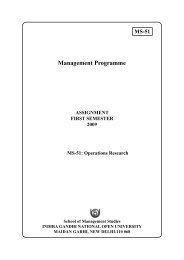PROSPECTUS AND PROGRAMME GUIDE - IGNOU
PROSPECTUS AND PROGRAMME GUIDE - IGNOU
PROSPECTUS AND PROGRAMME GUIDE - IGNOU
You also want an ePaper? Increase the reach of your titles
YUMPU automatically turns print PDFs into web optimized ePapers that Google loves.
7. Pattern of Management<br />
Broad policies and functions; Structural pattern of Board of Directors.<br />
Concept of public sector, social objectives, public sector management ; Current management thoughts<br />
Objectives<br />
Course 6<br />
BCO-042: Accounting<br />
To gain comprehensive understanding of all aspects relating to financial statements, Principles, Procedures of<br />
accounting and their application to different practical situations.<br />
Learning Aims<br />
The syllabus aim to test the student’s ability to:<br />
●<br />
●<br />
●<br />
Understand and explain the conceptual framework of Financial Accounting.<br />
Prepare accounts for various entities under various situations.<br />
Understand the nature and control of accounting systems.<br />
Skill set required<br />
Level A: Requiring the skill levels of knowledge and comprehension.<br />
1. Basics of Book-keeping and Accounting<br />
Definitions and its usefulness; Financial Accounting principles, concept and convention - measurement of business<br />
income; Position statement; Accounting Standards - national and international (basic knowledge).<br />
2. Systems of Book-keeping<br />
Double entry system, books of prime entry, subsidiary books; Recording of cash and Bank transactions; Preparation<br />
of ledger accounts; Preparation of trial balance - interpretation and usefulness.<br />
3. Bank Reconciliation Statements<br />
Need for reconciliation between cashbook and bank pass book and problems relating to the preparation of bank<br />
reconciliation statements.<br />
4. Accounting System<br />
Concept of capital, revenue, deferred revenue expenditures, opening entries, closing entries, adjustment entries<br />
and rectification entries; Accounting treatment for bad debts, reserve for bad debts and other adjusting entries;<br />
Depreciation- significance, accounting and various methods of calculation of depreciation; Concept of single<br />
entry system, conversion of single entry system into double entry system of accounting; Preparation of receipts<br />
and payments accounts, income and expenditure accounts; Significance of reserves and provisions; Bill of<br />
Exchange, consignment and joint venture.<br />
5. Elements of Cost Accounting<br />
Basics of cost and management accounting; Evolution of cost accounting and management accounting, cost<br />
concepts and cost object; Cost classification, cost organization and its relationship with other departments;<br />
Elements of cost and cost determination; Material cost-purchase procedure, store keeping and stock control,<br />
pricing issue material and accounting thereof, perpetual inventory and physical stock taking, identification of<br />
slow, non-moving and fast moving items, ABC analysis, JIT system, level of inventories and economic order<br />
quantity, analysis, investigation and corrective steps for treatment of stock discrepancies - control through other<br />
means; Labour costs - remuneration methods, monetary and non-monetary incentive schemes, payroll procedures,<br />
labour analysis and idle time, measurement of labour efficiency and productivity, analysis of non productive time<br />
and its cost, labour turnover and remedial measures, treatment of idle time and overtime; Direct expenses -<br />
nature, collection, classification and treatment of direct expenses; Overheads - nature, collection and classification;<br />
A-28



